
|

|
Forum Index : Electronics : INVERTERS - Why MOSFET’s fail....
| Page 1 of 2 |
|||||
| Author | Message | ||||
Grogster Admin Group Joined: 31/12/2012 Location: New ZealandPosts: 9308 |
Hi there fellow inverter constructors.  I found a couple of really good MOSFET guideline things on the net tonight. One is from Talking Electronics, and can be found here. Scroll right down to near the bottom of the page. I have also saved this as a ODT file here, Then there is High-speed MOSFET gate drive circuits , which is a 37 page PDF on the best practices driving gates when using MOSFET's in high-power applications - an interesting technical read. Smoke makes things work. When the smoke gets out, it stops! |
||||
| naiclub Newbie Joined: 07/09/2016 Location: ThailandPosts: 6 |
  |
||||
| Solar Mike Guru Joined: 08/02/2015 Location: New ZealandPosts: 1138 |
Could also be because what you think are genuine factory spec mosfets are fakes, especially if purchased from EBay or AliExpress. Whilst doing some initial designs for a 200+ amp solid state opto isolated relay module to replace some expensive gigavac type control relays I noticed the IRFP4568PbF mosfets were heating up a lot more than expected, so I built this simple test rig to measure their Rds on, basically a 12 volt bias supply, variable 50 volt 30 amp supply and a 2.5 ohm hot water heater element, see photo. 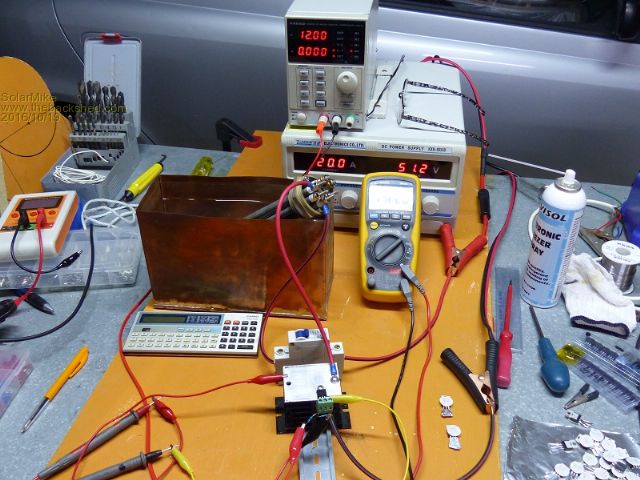 With 20 amps and measuring the mv across the mosfet drain\source itís easy to calc the resistance, in this case it was around 23 mOhms rather than the expected 4.8 - 5.9, closer examination of the device shows inconsistencies in the markings compared to that shown on the data sheets, ergo these fets are fakes, and yes purchased on EBay, well over 12 months ago now so cannot do much about it. However as Iím also constructing the OzInverter and had just received a batch of 50 IRFB4110 from the AliExpress supplier as published in other topics as source of parts for this project, thought it might be prudent to test them. The spec is around 4 mOhms at 20 degrees C with a 1.25 times increase @60c. Measuring all 50, the Rds variation was between 6.1 and 7.6 mOhms at room temp, which is pretty consistent but still approx. double what it should be; this was measured at 52v @20amps. I checked just a few at 60c and the increase was as per spec, ie it went up by 1.25 times. Rough calculations on a 6kw inverter, show peak currents in each mosfet around 45 amps so peak losses = 10 watts for spec devices and 23 watts for the fakes at 60c, thatís just for the RDs on, heaven knows what the other specs are eg input capacitance and switching speed. 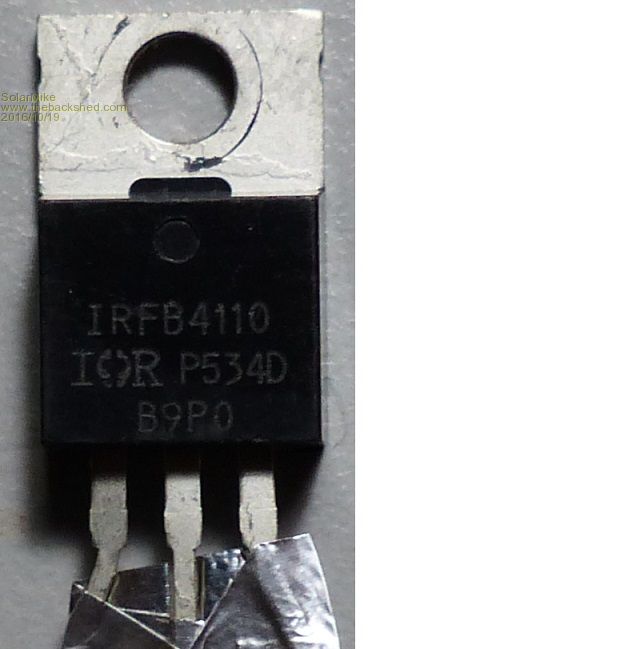 Notice the case markings are slightly different from the manufactures, the logo is slightly wrong and the top face indent dot is in the wrong place with no impression stamp in it, also the side copper base indents are not as distinct. This leads me to the conclusion these are also fakes, possibly cloned from another cheaper device that has been skimmed of original markings and re-done to look like the genuine article. I have contacted the supplier and they havenít responded, so have reflected that in the feedback about the sale. I will raise a dispute with them and see what happens. The main suppliers here in NZ are asking silly money for them and when compared to the same suppliers in the UK, over double the UK price for one supplier and way higher than the manufactures suggested prices, this is the prime reason for purchasing on EBay and the like, we are at the end of a long supply chain here in NZ and we pay for it. I think for the higher power inverters it may be worth considering to use these, the IRF4468, they have a good power rating and low on resistance. TO-247 package. Problem now, how do we spot the fakes, I looked at quite a few offerings and the photos of the devices in many cases show incorrect logos and positioning of markings, some look ok and their prices are generally higher, if anyone has tested the EBay\AliExpress devices and they meet spec please publish the link. Is it worth buying any of these devices on EBay? Cheers All Mike |
||||
Madness Guru Joined: 08/10/2011 Location: AustraliaPosts: 2498 |
Those IRFP4468PBF have some impressive specs but are nearly double the price of IRFP4110PBF at RS components. The IRFP4110PBF are TO-247 also Rs has them cheaper than the IRFB4110PBF. Their prices for 1 of each are IRFP4468PBF $11.24 IRFP4110PBF $6.53 IRFB4110PBF $7.01 All prices are AUD +GST, I know there are cheaper places, I have used RS occasionally as they delivery next day for free. But if the cheap Aliexpress ones for less than $1 each and as Oztules has said he has had some running for 18 months without a hiccup is it worth spending huge amounts more? Will the real McCoy's last longer? Or is it possible to get the real ones cheap. There are only 10 types of people in the world: those who understand binary, and those who don't. |
||||
Grogster Admin Group Joined: 31/12/2012 Location: New ZealandPosts: 9308 |
I'm using HY4008's in my design, which are TO247. 80v, 200A RDS(on)=2.9 milliohms. 800A surge rating. 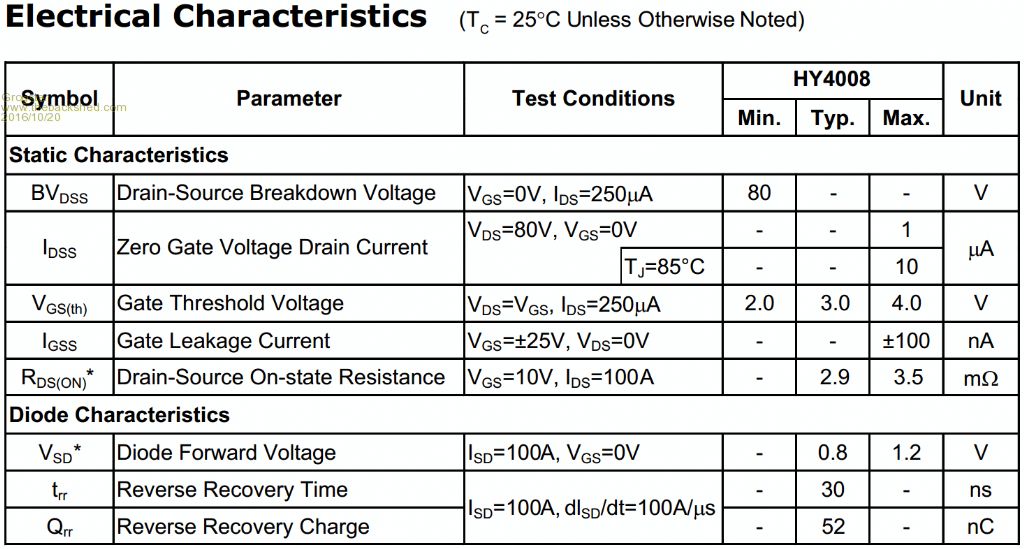 These are quite a common MOSFET in many inverter designs that I have seen, and the datasheet even says they are good for inverter power stages. Smoke makes things work. When the smoke gets out, it stops! |
||||
| Solar Mike Guru Joined: 08/02/2015 Location: New ZealandPosts: 1138 |
They do look very good Grogster, have you checked them for Rds. Do you have a link to the supplier. |
||||
Grogster Admin Group Joined: 31/12/2012 Location: New ZealandPosts: 9308 |
Link to PDF datasheet (3.2MB) They came from - ahem - AliExpress. Just search for the part number - there are plenty of them to choose from. No, I have NOT checked the RDS, and am going somewhat on the datasheet at this point in time, but BEFORE I use them in my inverter power board, I WILL be load testing each and every one. I am reasonably confidant that mine are genuine, as they are laser-engraved. A very common practise with the fake parts market, is to copy the markings and logo etc, but just print it on the part. I guess it is still possible to get laser-engraved fakes, but probably less likely, as the people making the fakes probably won't want to invest in a laser engraving machine just to produce fakes. False logic? Anyway, I am probably going to steal your idea for my testing, so that I can test the RDS - very useful method you posted there.  Smoke makes things work. When the smoke gets out, it stops! |
||||
| yahoo2 Guru Joined: 05/04/2011 Location: AustraliaPosts: 1166 |
it is no secret that the 4110's that have been used in the inverter are not genuine, and we have discussed testing and sorting and how much margin there should be, oztules has deliberately tested quite a few to destruction. we have pondered potential temperatures at the junction and the possibility of cumulative damage. they are not to genuine factory spec rather good enough to be fit for purpose at a price. from what I can see they are not going bang from extreme load or heat. if you are interested I can find a link to an EV site that has a topic that runs for thousands of posts on testing FET's, from memory the issue that kick it off was a couple of very reputable suppliers had a break in their supply chain. cheers I'm confused, no wait... maybe I'm not... |
||||
| Solar Mike Guru Joined: 08/02/2015 Location: New ZealandPosts: 1138 |
Guess you are right there Yahoo2, its nice to know the the OzInverter will run ok with these, providing of course that they havent drifted too far away from the manufactures spec, its prudent I think to check them first before soldering them in.  With my opto SSR though, I have had to bin the fake IRFP4568's as they were about 5 x the Rds spec and caused too much heat at 200 amps and re-order known original devices, its just so galling to have to do that.  |
||||
| LadyN Guru Joined: 26/01/2019 Location: United StatesPosts: 408 |
I am now in the same shoes as you all were 2 years ago and hence: https://www.thebackshed.com/forum/forum_posts.asp?TID=11137 Grogster, would you be able to reupload those documents, specially the "Why MOSFETs Fail.odt". I am assuming the "High-speed MOSFET gate drive circuits" is the TI AN, which I have both versions of (and trying to understand) That would be great to read up on! Do you remember those posts of his here or on other forums elsewhere? That would be VERY useful! |
||||
Grogster Admin Group Joined: 31/12/2012 Location: New ZealandPosts: 9308 |
Hi - here you are: 2019-03-01_080856_MOSFETS.zip Both files inside a ZIP. Download the ZIP file, and open to get the documents.  Smoke makes things work. When the smoke gets out, it stops! |
||||
| LadyN Guru Joined: 26/01/2019 Location: United StatesPosts: 408 |
thank you! Yes, the ANs by Laszlo Balogh is extremely insightful. Wish he was on this forum! I am starting to understand the issues highlighted in your ODT document but I don't think it discusses what is the dv/dt issue across DS and how the MOSFET can turn on even when Vds < Vth for that scenario. I really want to understand that better because dv/dt across DS might exceed due to ringing, say due to stray inductance and capacitance. And this can cause some very bad things to happen. |
||||
mackoffgrid Guru Joined: 13/03/2017 Location: AustraliaPosts: 460 |
N, I'm dealing with dv/dt, parasitic C atm. Its much more important when working with large mosfets as we are. There are several modes of induced turn-on, but dv/dt is mostly about the mosfets capacitance's and the fast rise of Vdrain. Plenty of resources on the net - google dvdt. cheers Andrew |
||||
| BenandAmber Guru Joined: 16/02/2019 Location: United StatesPosts: 961 |
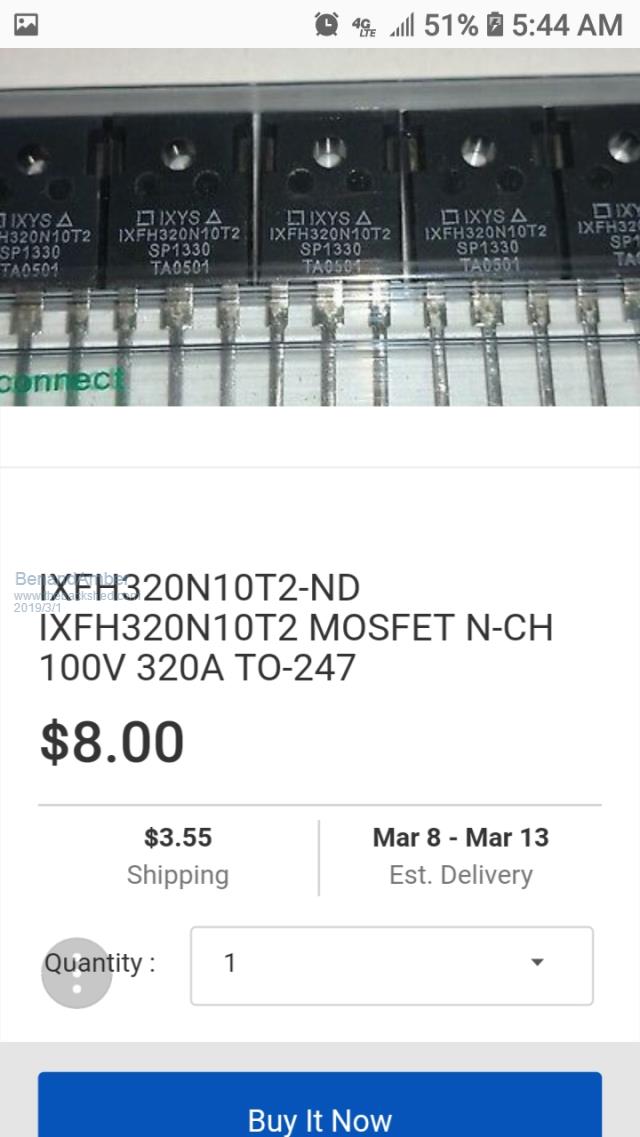 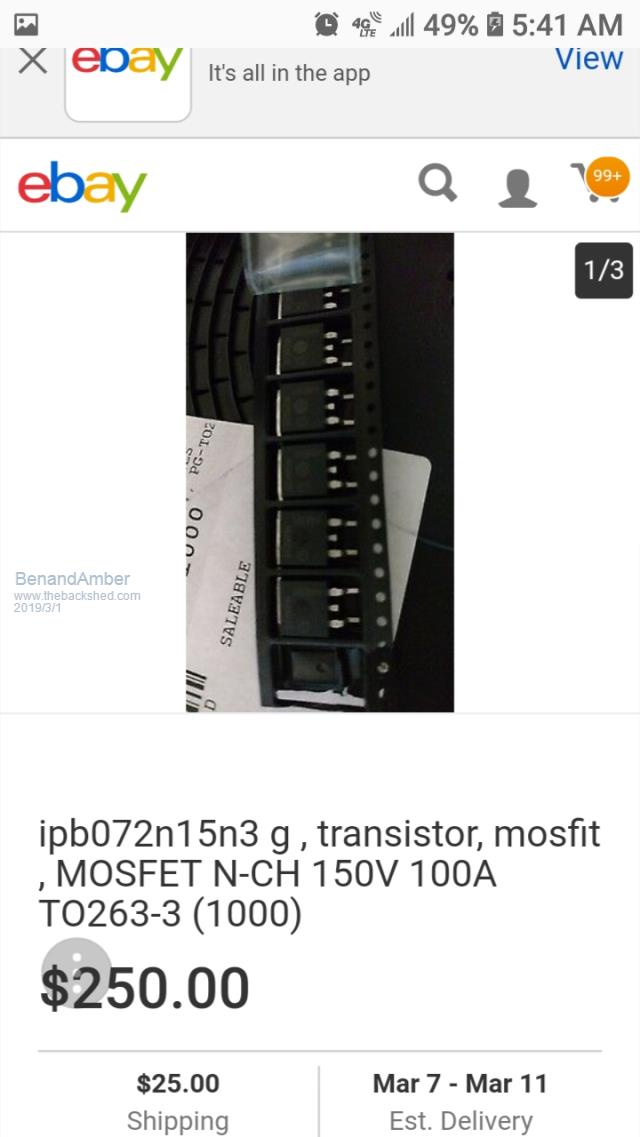 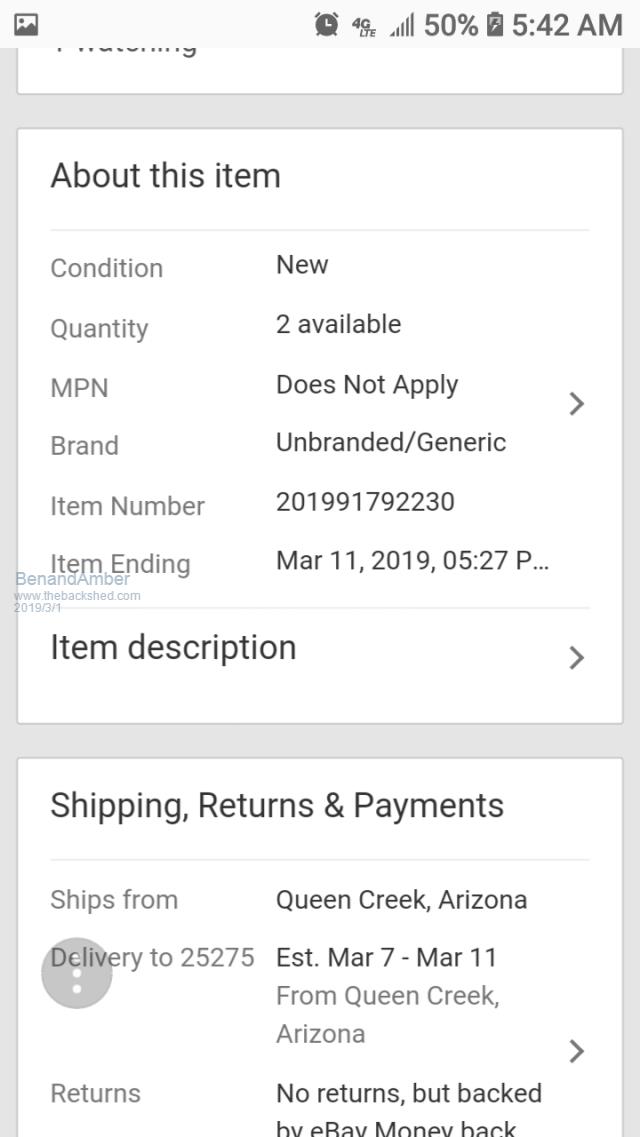 I don't know if this will help or not but this guy is selling a lot of inverter parts from a small inverter company that went under so I think the parts would probably be legit and not fakes he has quite a few different things these are a couple that caught my attention it's all in the USA eBay eBay item numbers in that one pic there's anything I can do to help anybody let me know hopefully this will help somebody be warned i am good parrot but Dumber than a box of rocks |
||||
Grogster Admin Group Joined: 31/12/2012 Location: New ZealandPosts: 9308 |
Yes, you are right, and other members here have said as much. I expect it is not really a problem with switching low currents(say under 10A), but with the kind of primary current flowing around an inverter primary driver, ANYTHING you get wrong will be rewarded with that magic smoke. And as my signature says, it's the smoke that makes it work. Once the smoke gets out, everything stops, and it is very hard to get the smoke back in again.  I expect this is somewhat similar in inverter terms, to a parasitic oscillation inside a transmitter final. Sometimes, if the final becomes unstable, or you are testing an RF amp you built yourself, they can self-oscillate, and this oscillation runs away somewhat like a Diesel engine runaway - and with the same result, generally, in that the RF final blows itself to bits very quickly. Usually before you realise what is going on and can stop it!  Not good, and not a wanted feature.  Smoke makes things work. When the smoke gets out, it stops! |
||||
| Warpspeed Guru Joined: 09/08/2007 Location: AustraliaPosts: 4406 |
All this is very true, but... When you start connecting multiple mosfets in parallel, there is no real assurance that they are all going to turn on and off simultaneously. The fastest device that turns on first, and the slowest device that turns off last may be forced to carry vastly higher peak transient current than just the assumed average of several parallel devices. Matching the Rds on is only a very small part of the problem, they will "tend" towards dc current balance anyway, because the hottest device(s) will increase in resistance and carry proportionately less current. High frequency PWM can work very well at low power with only four individual devices in a bridge. But scaling it up by just paralleling up more mosfets in each leg can introduce a lot of new issues. Another problem usually totally misunderstood by the novice, is device derating, and how the published data (as it is presented) can be very misleading and often just not realistic or reachable in a real world circuit. Even if the part is an authentic premium quality part. Cheers, †Tony. |
||||
Grogster Admin Group Joined: 31/12/2012 Location: New ZealandPosts: 9308 |
Good point. That's certainly true.  The datasheets tell you what the device is CAPABLE of, more then that it suits your application per se'. Take the good old fashioned linear regulators such as a 350T for example. "Guaranteed 3A output" it says in the PDF, but if you feed it 15v, set it for 5v output @ 3A it is trying to dissipate (15-5)*3=30W of heat. Most TO220 regulators would overheat and shut down rather quickly if you try to make them dissipate thirty watts!  In other words, to get that 3A output, your input-output voltage differential must be as close to the 2.5v dropout of the regulator as possible - say 3v or so, and even then, linear's get pretty hot! ((8-5)*3=9 Watts, so pretty damn hot at 3A even under ideal-ish conditions.) That is but ONE simple example surrounding one device.  Smoke makes things work. When the smoke gets out, it stops! |
||||
| poida Guru Joined: 02/02/2017 Location: AustraliaPosts: 1419 |
I just added a post discussing shoot through and I thought we might find it worthwhile. here wronger than a phone book full of wrong phone numbers |
||||
| LadyN Guru Joined: 26/01/2019 Location: United StatesPosts: 408 |
I really appreciate the post and this update Peter Please understand that I completely and absolutely lack the power electronics knowledge each of you have, so anything I can learn as I slowly progress knowing more REALLY helps me a lot. I will keep asking questions until you all get tired of me! |
||||
| BenandAmber Guru Joined: 16/02/2019 Location: United StatesPosts: 961 |
I second that appreciation thanks guys I am slow but if u guys keep writing I will eventually get it be warned i am good parrot but Dumber than a box of rocks |
||||
| Page 1 of 2 |
|||||